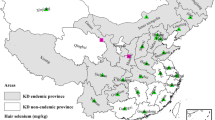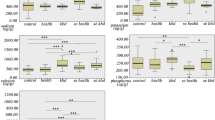Abstract
The objective of this study was to investigate the relationship between selenium content in hair and the incidence of Kashin-Beck disease (KBD) and Keshan disease (KD) in China. A prospective cohort study was conducted among children aged 5–12 years with different levels of low-selenium (group 1, Se ≤ 110 ng/g; group 2, 110 < Se ≤ 150 ng/g; and group 3, 150 < Se ≤ 200 ng/g) or selenium-supplemented (group 4, Se > 200 ng/g) exposure. A person-years approach was used to calculate the incidence and rate of positive clinical signs. Relative risk (RR), attributable risk, and etiologic fraction were used to determine the strength of association between selenium and disease incidence. Seven new KBD cases were diagnosed during 3-year follow-up. Positive clinical signs of KBD were found in 17.78 (95% confidence interval [CI] 14.27–21.29) cases per 100 person-years in group 1, 13.28 (9.82–16.74) in group 2, 12.95 (9.34–16.56) in group 3, and 8.18 (5.50–10.85) in group 4. Compared with group 4, the RR (95% CI) of groups 1, 2, and 3 were 2.17 (1.48–3.19), 1.62 (1.07–2.47), and 1.58 (1.03–2.43), respectively. Positive clinical signs of KD were 25.90 (18.62–33.18) cases per 100 person-years in group 1, 5.66 (1.26–10.06) in group 2, 4.60 (0.20–9.00) in group 3, and 14.62 (8.54–20.69) in group 4. Compared with group 4, the RR (95% CI) were 1.77 (1.07–2.93), 0.39 (0.16–0.93), and 0.31 (0.11–0.89), respectively. In children, the onset of KBD was negatively correlated with selenium content within a certain range. However, there may be a U-shaped association between selenium content and KD in children.




Similar content being viewed by others
References
Li S, Xiao T, Zheng B (2012) Medical geology of arsenic, selenium and thallium in China. Sci Total Environ 421-422:31–40
Loscalzo J (2014) Keshan disease, selenium deficiency, and the selenoproteome. N Engl J Med 370:1756–1760
Guo X, Ma WJ, Zhang F, Ren FL, CJ Q, Lammi MJ (2014) Recent advances in the research of an endemic osteochondropathy in China: Kashin-Beck disease. Osteoarthr Cartil 22:1774–1783
Hinsenkamp M (2001) Kashin-Beck disease. Int Orthop 25:133
National Health and Family Planning Commission of the PRC (2013) China health statistics yearbook 2013. In: http://www.nhfpc.gov.cn/htmlfiles/zwgkzt/ptjnj/year2013/index2013.html
Xiang Y, Xu Q, Tan W, He S, Shi X, Zhang W, Wang J, Wang X, Ma W (2014) Serum biomarkers of Keshan disease assessed using a protein profiling approach based on ClinProt technique. Protein J 33:344–353
Ge K, Xue A, Bai J, Wang S (1983) Keshan disease—an endemic cardiomyopathy in China. Virchows Arch A Pathol Anat Histopathol 401:1–15
Moreno-Reyes R, Suetens C, Mathieu F, Begaux F, Zhu D, Rivera MT, Boelaert M, Neve J, Perlmutter N, Vanderpas J (1998) Kashin-Beck osteoarthropathy in rural Tibet in relation to selenium and iodine status. N Engl J Med 339:1112–1120
Oropeza-Moe M, Wisloff H, Bernhoft A (2015) Selenium deficiency associated porcine and human cardiomyopathies. J Trace Elem Med Biol 31:148–156
Zeng LX, Xu P, Schrauzer GN, Guo X (1999) Logistic analysis and content of 39 elements in hair of children between Kashin-Beck diseased areas and non-Kashin-Beck disease areas. Chin J Endemiol 18:445–449
Moreno-Reyes R, Mathieu F, Boelaert M, Begaux F, Suetens C, Rivera MT, Neve J, Perlmutter N, Vanderpas J (2003) Selenium and iodine supplementation of rural Tibetan children affected by Kashin-Beck osteoarthropathy. Am J Clin Nutr 78:137–144
Mo DX, Ding DX, Wang ZL, Zhang JJ (1997) Study on relationship between selenium and Kashin-Beck disease in 20 years. Chin J Contr Endem Dis 12:18–21
FF Y, Han J, Wang X, Fang H, Liu H, Guo X (2016) Salt-rich selenium for prevention and control children with Kashin-Beck disease: a meta-analysis of community-based trial. Biol Trace Elem Res 170:25–32
Group KDR (1979) Observations on effect of sodium selenite in prevention of Keshan disease. Chin Med J 92:471–476
Mo D, Ding D, Wang Z, Zhang J, Bai C (1997) Study on relationship between selenium and Kashin-Beck disease in 20 years. Chin J Ctrl Endem Dis 12:18–21
Guo X, Shiyuan Z, Dongxu M (1999) A role of low selenium on the occurrence of Kashin-Beck disease. Chin J Ctrl Endem Dis 8:82–84
Wang HY, Chen Z (2008) A matched study of the relationship between Kashin-Beck disease and selenium content in hair. Chin J Ctrl Endem Dis 23:59–60
Li Q, Zhao ZJ, Yang PZ, XQ X, Liu YF, HZ Y, Ma X, Du R, Zhu L (2016) The prevention effect of selenium on prevalence of children Kashin-Beck disease in active endemic areas in Qinghai Plateau. Biol Trace Elem Res 169:17–21
Chen X, Yang G, Chen J, Chen X, Wen Z, Ge K (1980) Studies on the relations of selenium and Keshan disease. Biol Trace Elem Res 2:91–107
Ma JS, Xu XQ (1995) Analysis of the incidence and death of Keshan disease before and after selenium supplementation. Chin J Endem 14:68–169
Chen J (2012) An original discovery: selenium deficiency and Keshan disease (an endemic heart disease). Asia Pac J Clin Nutr 21:320–326
Jr GFC, Combs SB (1986) The Role of selenium in nutrition. Academic Press, Boca Raton, pp 196–199
Ortaç E, Ozkaya O, Saraymen R, Yildiz N, Bedir A, Buyan N, Bek K, Okuyucu A, Baysal K (2006) Low hair selenium and plasma glutathione peroxidase in children with chronic renal failure. Pediatr Nephrol 21:1739–1745
Yang G, Zhou R, Yin S, Gu L, Yan B, Liu Y, Liu Y, Li X (1989) Studies of safe maximal daily dietary selenium intake in a seleniferous area in China. I. Selenium intake and tissue selenium levels of the inhabitants. J Trace Elem Electrolytes Health Dis 3:77–87
Combs GF Jr (2015) Biomarkers of selenium status. Nutrients 7:2209–2236
Xu GY, Zhang BD, YL X (2005) Summary report of Kashin–Beck disease prevention of Shaanxi Province. Endemic Dis Bull (China) 20:64–65
Koh TS, Benson TH (1983) Critical re-appraisal of fluorometric method for determination of selenium in biological materials. J AOAC 66:918–926
Kim SH, Hwang WJ, Cho JS, Kang DR (2016) Attributable risk of lung cancer deaths due to indoor radon exposure. Ann Occup Environ Med 28:8
Sasco AJ (1987) Etiologic fraction in case-control studies for the evaluation of screening. J Chronic Dis 40:368
Hou J, Wang T, Liu M, Li S, Chen J, Liu C, Zhang H, Wang Y, Liu Z, Liang N, Wan Y, Li Q, Sun S, Zhang L, Feng H, Liu Y, Wang H (2011) Suboptimal selenium supply—a continuing problem in Keshan disease areas in Heilongjiang province. Biol Trace Elem Res 143:1255–1263
Gore F, Fawell J, Bartram J (2010) Too much or too little? A review of the conundrum of selenium. J Water Health 8:405–416
Bleys J, Navas-Acien A, Laclaustra M, Pastor-Barriuso R, Menke A, Ordovas J, Stranges S, Guallar E (2009) Serum selenium and peripheral arterial disease: results from the national health and nutrition examination survey, 2003-2004. Am J Epidemiol 169:996–1003
Bleys J, Navas-Acien A, Guallar E (2008) Serum selenium levels and all-cause, cancer, and cardiovascular mortality among US adults. Arch Intern Med 168:404–410
Group KDR (1976) The difference of selenium content in whole blood of Keshan disease endemic area and non-endemic areas, and the relationship between plasma selenium and hair selenium. Health Res 0:259–263
Rayman MP (2012) Selenium and human health. Lancet 379:1256–1268
Rayman MP (2000) The importance of selenium to human health. Lancet (London, England) 356:233–241
Stranges S, Navas-Acien A, Rayman MP, Guallar E (2010) Selenium status and cardiometabolic health: state of the evidence. Nutr Metab Cardiovasc Dis 20:754–760
Yang GQ, Xia YM (1995) Studies on human dietary requirements and safe range of dietary intakes of selenium in China and their application in the prevention of related endemic diseases. Biomed Environ Sci 8:187–201
Keshavarzi B, Moore F, Najmeddin A, Rahmani F (2012) The role of selenium and selected trace elements in the etiology of esophageal cancer in high risk Golestan province of Iran. Sci Total Environ 433:89–97
Wang X, Wang S, He S, Zhang F, Tan W, Lei Y, Yu H, Li Z, Ning Y, Xiang Y, Guo X (2013) Comparing gene expression profiles of Kashin-Beck and Keshan diseases occurring within the same endemic areas of China. Sci China Life Sci 56:797–803
Tsavachidou D, McDonnell TJ, Wen S, Wang X, Vakar-Lopez F, Pisters LL, Pettaway CA, Wood CG, Do KA, Thall PF, Stephens C, Efstathiou E, Taylor R, Menter DG, Troncoso P, Lippman SM, Logothetis CJ, Kim J (2009) Selenium and vitamin E: cell type- and intervention-specific tissue effects in prostate cancer. J Natl Cancer Inst 101:306–320
Yang FY (1993) Trace elements and the erythrocyte membrane skeleton in people (in Chinese). Prog Nat Sci 3:481–487
Acknowledgments
We thank the children and families who participated in this study.
Funding
This work was supported by grants from the National Natural Science Foundation of China (81472924, 81620108026), and the Fundamental Research Funds for the Central Universities.
Author information
Authors and Affiliations
Contributions
X Guo and Mikko J. Lammi conceived and designed the experiments; DX Ding, ZD Yu, FS Chen, D Geng, and XW Tan performed the experiments; FF Yu, WZ Shao, and H Liu analyzed and interpreted the data; H Liu wrote the paper; and H Liu had primary responsibility for final content. All authors read and approved the final manuscript.
Corresponding authors
Ethics declarations
This investigation was approved by the Institutional Review Board of Xi’an Jiaotong University. Informed consent was obtained from a parent/guardian of each child at study entry and at follow-up.
Conflict of Interest
The authors declare that they have no conflict of interest.
Rights and permissions
About this article
Cite this article
Liu, H., Yu, F., Shao, W. et al. Associations Between Selenium Content in Hair and Kashin-Beck Disease/Keshan Disease in Children in Northwestern China: a Prospective Cohort Study. Biol Trace Elem Res 184, 16–23 (2018). https://doi.org/10.1007/s12011-017-1169-x
Received:
Accepted:
Published:
Issue Date:
DOI: https://doi.org/10.1007/s12011-017-1169-x




